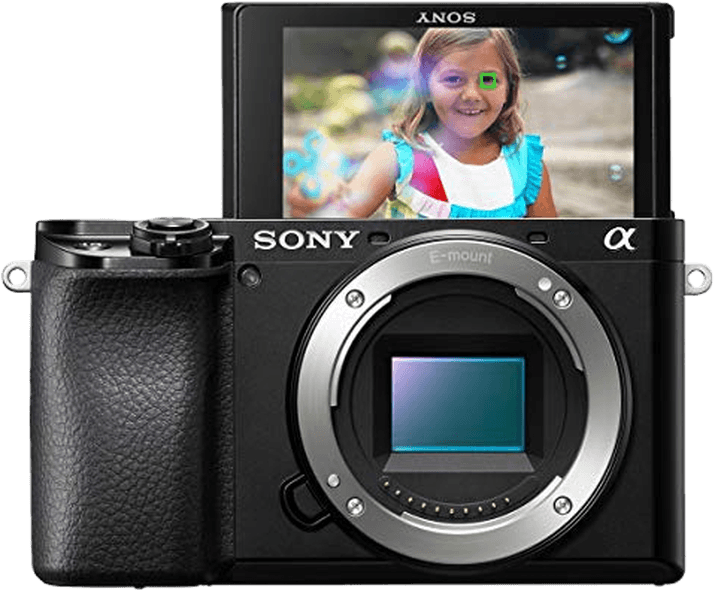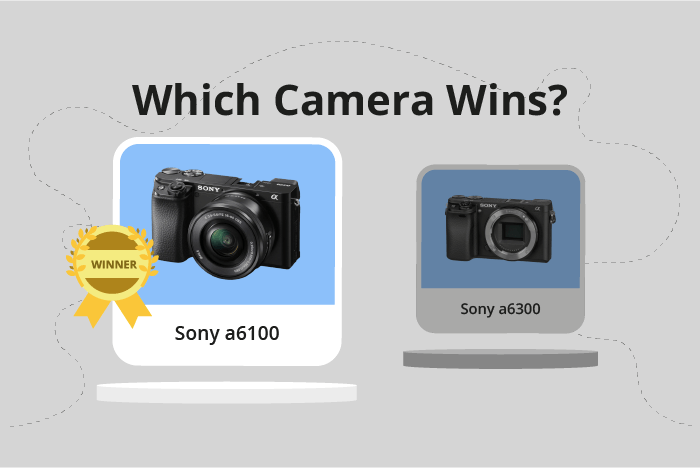Sony a6100 vs a6300 Comparison
Sony a6100

Sony a6300

The Sony a6100 emerges as the winner with a score of 66/100, compared to the Sony a6300‘s score of 61/100. Both cameras are mirrorless and share similar dimensions, with the a6100 measuring 120 x 67 x 59mm and the a6300 measuring 120 x 67 x 49mm. They also have similar weights, with the a6100 weighing 396g and the a6300 weighing 404g.
The a6100 has an advantage due to its more recent release in 2019, compared to the a6300’s 2016 release. Additionally, the a6100 has a lower launch price of $750, making it more affordable than the a6300’s $1000 launch price. This gives the a6100 an edge in terms of value for money.
On the other hand, the a6300 has a slightly slimmer design, being 10mm thinner than the a6100. This may make it more appealing to those looking for a more compact camera. However, this difference is minimal and may not be significant for most users.
Taking these factors into account, the Sony a6100 proves to be the better option due to its higher score, affordability, and more recent release date. While the a6300 has a slightly slimmer design, it is not enough to outweigh the benefits of the a6100.
Sony a6100 vs a6300 Overview and Optics
The Sony a6100 and the Sony a6300 both have an optics score of 68/100, indicating no clear winner in this category. These cameras share several specifications, including a 24-megapixel count for the a6100 and a slightly higher 24.2-megapixel count for the a6300. Both cameras have a shooting speed of 11 frames per second, a CMOS sensor type, a Bionz X processor, an APS-C sensor size, a Sony E lens mount, and no image stabilization.
The a6300 has a higher DXOMARK score for the sensor at 85, compared to the a6100’s score of 82. This difference gives the a6300 a slight edge in terms of sensor performance. However, the a6100 still performs well, especially considering its lower price point.
In terms of optics, neither camera has a significant advantage over the other. Both cameras perform well in this category, with the a6300 having a slight edge in sensor performance. However, the a6100 remains a strong contender, offering similar specifications at a lower price point.
Considering the shared optics specifications and the minor differences in sensor performance, both the Sony a6100 and the Sony a6300 are solid choices for photographers seeking a high-quality camera. The decision between the two ultimately depends on individual preferences and budget constraints.
Sony a6100 vs a6300 Video Performance
When comparing the video capabilities of the Sony a6100 and the Sony a6300, both cameras are evenly matched with an identical video score of 91/100. This indicates that they both excel in this area, providing users with impressive video performance.
The Sony a6100 and the Sony a6300 share several key video specifications. Both cameras boast a maximum video resolution of 4K, ensuring high-quality footage with sharp details. They also have the same maximum video dimensions of 3840 x 2160, further enhancing the clarity of the videos. In addition, both cameras are capable of recording at a maximum video frame rate of 120fps, allowing for smooth slow-motion footage. Lastly, both cameras come equipped with built-in time-lapse functionality, giving users the ability to create stunning time-lapse videos with ease.
Despite the tied video score, there are some areas where one camera may be slightly better than the other. However, these differences are generally minor and may not impact the overall video performance significantly. In this case, both the Sony a6100 and the Sony a6300 have identical specs, making it difficult to determine a clear winner.
Considering the shared specifications and identical video scores, it is safe to say that both the Sony a6100 and the Sony a6300 offer exceptional video capabilities. Users can expect high-quality footage, smooth slow-motion recording, and impressive time-lapse videos from either camera. As a result, the choice between these two cameras should be based on factors other than video performance, such as price, additional features, or personal preference.
Sony a6100 vs a6300 Features and Benefits
The Sony a6100 emerges as the winner in the features comparison, scoring 68/100, while the Sony a6300 scores 54/100. Both cameras share several specifications, such as a 3-inch screen size, 921,600-dot screen resolution, a flip screen, no GPS, and WIFI connectivity. However, there are differences that make one camera stand out over the other.
The Sony a6100 is superior due to its touchscreen and Bluetooth capabilities. The touchscreen allows for more intuitive and seamless navigation through menus and settings, while Bluetooth enables easier and more efficient connectivity with other devices, such as smartphones and tablets. These additional features make the a6100 more user-friendly and versatile.
On the other hand, the Sony a6300 does not offer any significant advantages over the a6100. It lacks both a touchscreen and Bluetooth, which puts it at a disadvantage in terms of usability and connectivity. As a result, the a6300 does not excel in any particular aspect compared to the a6100.
Considering the points mentioned above, the Sony a6100 is the better choice due to its added features, such as touchscreen and Bluetooth capabilities. These features enhance the user experience and provide more convenience when using the camera. The Sony a6300, while sharing some specifications with the a6100, does not offer any significant advantages that would make it a better choice. Therefore, the Sony a6100 is the recommended camera for those seeking a more feature-rich and user-friendly option.
Sony a6100 vs a6300 Storage and Battery
The Sony a6100 outperforms the Sony a6300 in storage and battery with a score of 37/100 compared to the a6300’s 24/100. Both cameras share identical specifications in terms of memory card slots and the types of memory cards accepted. They each have one memory card slot and accept SD/SDHC/SDXC cards, with the a6100 also supporting Memory Stick Pro Duo cards.
The a6100 has a longer battery life, providing 420 shots, while the a6300 offers 400 shots. Both cameras use the same NP-FW50 battery type. The a6100 has the additional advantage of USB charging, which the a6300 lacks.
The Sony a6300 does not have any advantages in storage and battery over the a6100. In this comparison, the Sony a6100 is the clear winner due to its longer battery life and USB charging capability. This makes the a6100 a better choice for those prioritizing longer shooting sessions and convenient charging options.
Sony a6100 vs a6300 – Our Verdict
Are you still undecided about which camera is right for you? Have a look at these popular comparisons that feature the Sony a6100 or the Sony a6300:

